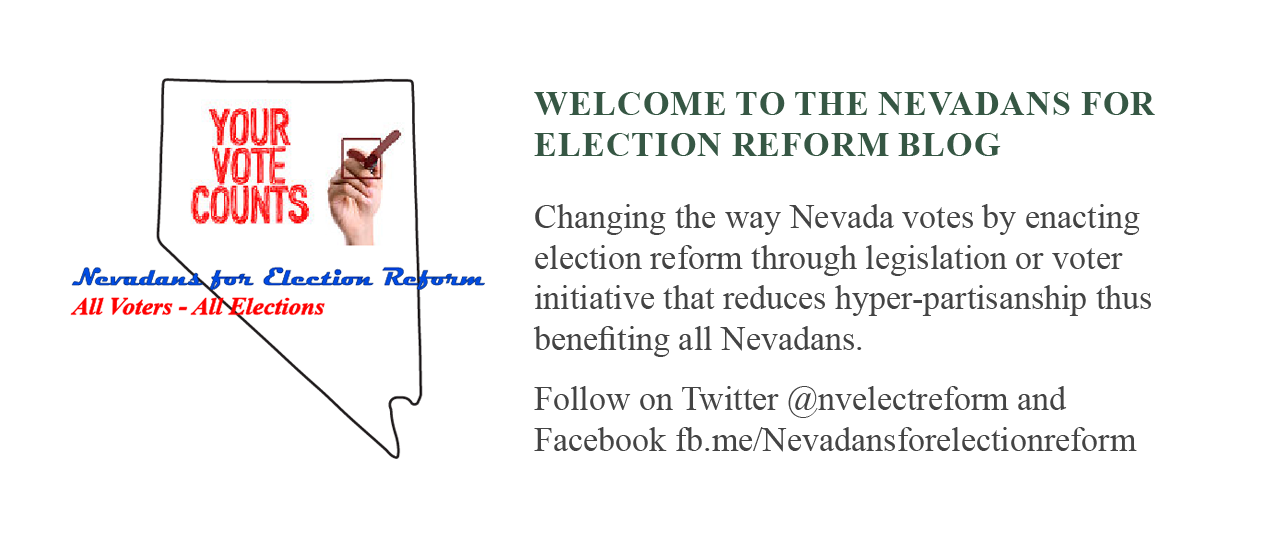When the Nevada Election Modernization and Reform Act
(NEMRA) was filed as Bill Draft Request (BDR) 1149 for the 2015 session of the
Nevada Legislature, the Legislative Council Bureau (LCB) issued the following
opinion:
“After researching the
constitutionality of the BDR,
we believe that the "instant runoff" system violates: (1) Section 4 of Article 5
of the Nevada Constitution, which requires that candidates "having the highest number of votes" be
declared elected; and (2) Section 14 of Article is, which provides that a candidate wins an
election by receiving a "plurality" of votes (rather than a majority of votes). The proposed instant runoff system violates these provisions
because it prohibits a candidate who receives the highest number of votes from being declared the winner unless the candidate receives a majority (i.e., 50 + 1) of votes. (According to our research, a number of municipalities nationwide have implemented instant runoff systems, while other states have implemented instant runoff systems
only in limited circumstances. In each of those instances, the constitutions for the states do
not have analogous provisions that would have prohibited instant runoffs in the
municipalities or in the limited circumstances that the states
were using instant runoff for. California's original constitution from 1849
had a provision similar to the "plurality" provision of
Section 14, Article is, but that provision was not
retained when California adopted a new constitution in 1879.)”
This opinion resulted in the bill, SB 499, being introduced
as a modified top-two non-partisan open primary. Following
a hearing
before the Senate Legislative Operations and Elections Committee, the original
language of the bill was replaced with language extending the candidate filing
deadline for minor party and independent candidates. That language was passed
by both chambers of the legislature and approved by the governor. But does
Ranked Choice / Instant Runoff Voting (RCV / IRV) violate the two referenced
sections of the state Constitution? Probably not.
Section 4 Article
5 of the Nevada
Constitution addresses the transmittal and canvassing of votes of the general
election. RCV / IRV is a process used to determine
the candidate with the highest number of votes. The question is what
constitutes a “vote”. According to a former director of the Legislative Counsel
Bureau, language in the bill stating the ranking of candidates constitutes a
“vote” for the purpose of Section 4 Article 5 and that the candidate who is
determined to have the highest number of votes under the process is determined
to have the highest number of votes under the meaning of Section 4 Article 5
should resolve the constitutional question.
Section 14 Article
15 is one sentence; “A plurality of votes given at an election by the people,
shall constitute a choice, where not otherwise provided by this Constitution[.]” The constitutionality of RCV / IRV is being questioned
because it is a common belief that RCV / IRV requires the eventual winner of an
election to have received a clear majority of the total votes cast. This is not
correct. Because ballots become exhausted before the final round of tabulation
or some voters do not mark a second choice, RCV / IRV is in fact a plurality
voting system. The winner does have a
majority of votes counted in the final round but not necessarily a majority of
the total votes cast. This can be seen in the results of the 2014 election for
Mayor in Oakland,
California (63.2% final, 46.5% total votes cast)
and the 2011 elections for Mayor in San
Francisco, California (59.8% final, 43.4% total
votes cast) and Portland,
Maine (55.8% final, 45.9% total votes cast). A
2003 opinion by the Attorney General for the
state of Texas also supports that RCV / IRV is not a majority voting system.
Texas law requires winners of an election receive a majority of the total votes
cast. The opinion prevented a city from implementing RCV / IRV because it does
not meet this requirement.
I am currently working on getting
NEMRA, either in its original form or slightly modified, back before the Nevada
legislature in 2017. An important part of that process is addressing the
concerns of the LCB. The above facts represent the start of that process.

